Posted by
Susan Sharma
on
April 14, 2014
The Permaculture garden is a lot more than an organic garden.
In permaculture gardens (home systems is the more holistic term) there is rarely bare soil, the conservation of soil and water is a high priority. There is a more complex use of space. Plants are allowed to set seed and are interplanted for pest control.
You are unlikely to see plants in rows......
The permaculture system aims to harvest and maximise water, sun and other natural energies, e.g. wind, dust, leaves, bird droppings.
The permaculture system aims to provide nutritious food and habitat for people AND native animals and birds.
Read More at
|
Posted by
Susan Sharma
on
August 09, 2011


The labernum is in full bloom announcing the summer season ahead. Labernum is native to India and is venerated by Indians as a "lucky charm". The pretty dangling flowers cannot be missed where labernum grows as avenue trees or as
a tree welcoming one to a house.

Another tree, the silver oak (Grevillea robusta)an exotic from Australia which is now very popular in urban parks, also blooms. Very few take notice, as the blooms quickly transform to seeds. A fact which is least known about this tree is that its flowers
and seeds are known to cause dermatatis. The flowers are golden-orange washing brush like blooms and are toxic.

The ground is awash with yellow blooms as soon as it rains. Pretty lilies bloom to welcome the short rainy season in these parts.
The yellow and white butterflies are common now.
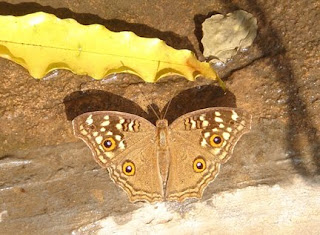
Not so common, is the yellow lemon pansy.
The birds are busy nesting and bringing up new chicks to feed in the abundance of the rainy season. The bulbul decides to make her nest just outside our main door, on a Christmas tree. She has been very clever. The tree pie is on the look out for eggs
every day morning and one day we woke up to bulbul cries. Luckily the nest attacked was not the one near the door, but the one on a ficus tree outside the gate, on the main road. Her nest is resting on a branch near the wall of our house. No big bird can
reach it. The height is such that the prowling alley cat will not jump at it either. But every time someone comes out of the house, the male or female(they take turns) sitting on the nest is disturbed and flies out to the nearest tree.

We are honoured at the trust imposed by the bulbul in us.

When the little chick flew out for the first time leaving the nest vacant, we celebrated.
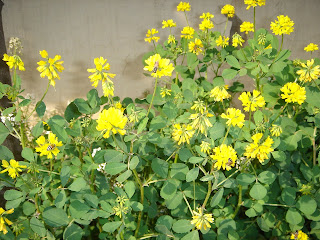 Methi
(Fenugreek) is flowering too and attracts honey bees on the yellow flowers Methi
(Fenugreek) is flowering too and attracts honey bees on the yellow flowers
Bye bye season of yellows till next time!
|
Posted by
Koushik Ranjan Das
on
July 02, 2011

“My Sunday noon: Urban Squirrel watch from my balcony”.
On one lazy Sunday noon while standing on my balcony I noticed one small squirrel playing on the sunshade
and water-pipes of a nearby house. I glued my eyes to and found it in a playful mode. I have hardly captured any squirrel as I am interested with people and places, but that time I became very much interested with this tiny loving creature. To capture a squirrel
movement is a tuff job, but I fixed up my mind to follow it and shoot it as an assignment and “ON ASSIGNMENT”. I watched and captured it to play, relax, giving anxious call, run & jump, fight with the crows and Salikhs for a piece of bread and also a strange
thing I have noticed about it : to eat the dried white crow-shit (may be for calcium enrichment) <Picture SQ35>. Also I am lucky enough to freeze it’s long tongue movement. Later I found it as a female and she was carrying. She made her nest behind a hollow
of a gutter-pipe of that house, may be for giving birth to her babies. I am still keeping my eyes on her and eagerly waiting for her proud pose with babies. I don’t know whether I could make it or not. (#I am shooting with my Canon 450D and Nikon D7000).
See the photographs in my facebook album:
http://www.facebook.com/media/set/?set=a.162230330502755.37396.100001473686962&l=41d1305e4e
|
Posted by
Susan Sharma
on
May 17, 2011
The once-exotic bird is becoming a notorious pest as it enjoys a population
explosion in many London suburbs.
"There is wide agreement that the Adams and Eves behind the current
population boom did not fly here from Asia or Africa but escaped from
British pet cages or were intentionally released by their owners. The great
mystery is what allowed the parakeets to procreate with such phenomenal
success just in the past decade."
Read more at the link
http://www.nytimes.com/2011/05/14/science/earth/14parakeet.html?_r=3
or
http://tinyurl.com/5us2w4y
|
Posted by
Fabiola Jacob
on
July 01, 2010

Just outside my apartment window off Santhome High Road in Chennai, are a row of trees reaching up to the 3rd floor. The trees host a variety of birds – many I’m seeing for the first time, and with the Internet, able to identify.
For as long as I remember, there have been crows and squirrels in plenty, with a fair share of the Common Sparrow thrown in. But in recent times, the common sparrows have dwindled in number, and are rare to find. But many other birds have become frequent visitors
– largely due to the upcoming Adyar Eco Park that’s just a stone throw away from here.
A small group of Coppersmith Barbets are one of the most frequent and my favourite visitors. The first time I set my eyes on one of them, I was captivated by their beauty. Only as big as the sparrow, with glossy greenish wings and plumes of
red and yellow on the crown and chest – they are truly a piece of art! And their call is so unique a “tuk…tuk…tuk…” that resembles a coppersmith banging on the metal – and hence their name. And once you hear that sound – it’s almost impossible not to recognize
where it comes from. Creatures of habit, they seem to be, and make themselves present on the same branches everyday at morning before the sun gets too harsh, and in the evening at dusk. The other day, I spotted a curious little fellow just outside my wind
– craning his neck to listen to my daughter practicing on the Piano!
And then there are the Black Drongos, who think they own the air space! The fiercest fighters of the bird world, their aerial sorties while chasing the crows are just as thrilling as the ones we see at air shows. And that brings me to the subject
of the crows who seem to be sharing India’s predicament – a population explosion. With a surge in number comes food scarcity, as the crows these days are never content with scavenging – and so they fly in and out of balconies, helping themselves to food straight
from the kitchen, rummaging in other nests, eating eggs, feeding on fledglings and generally creating a ruckus.
But the crows are not really as smart as they seem. They are frequently outwitted by the
Asian Koel that often usurps its nest and even fools the crow into raising its young. When the crow is away, the Koel pushes out the crow’s eggs from its nest and lays its own. And then the gullible crow sits on the eggs, hatches it and rears
the young – though the fledgling looks and sounds so very different from its own young. I guess this is what that Victorian idiom “penny-wise, pound-foolish” actually means!
And just outside my balcony is this industrious little squirrel, busy building her nest – for about a week now. From dawn till dusk, she runs up and down the tree, collecting building material that includes tiny twigs, fiber, coir, cotton, foam and even sheets
of plastic! Her nest looks cozy now, and I’m looking forward to seeing her little ones soon.
There are many other birds too – mynahs prowling the ground on their dainty feet and tailor birds looking for leaves to stitch up. And even as I’m blogging, there is this tiny brown fellow with a grayish chest and belly preening on one of the branches. His
mate is here too, flitting among the leaves. They are so tiny, smaller than even the tailor bird – I just can't wait to google them out… now!
|
Posted by
Susan Sharma
on
February 14, 2010
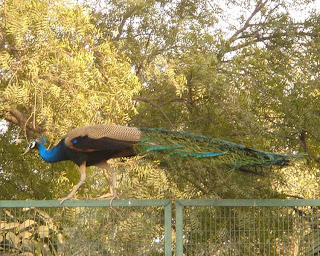 At last the cold winter of 2010 is on its way out and spring is here again. The redstart which heralded winter for us, is all set to disappear to higher plains till the weather beckons again.
At last the cold winter of 2010 is on its way out and spring is here again. The redstart which heralded winter for us, is all set to disappear to higher plains till the weather beckons again.
 The nasturium flower smiling at the sun gives itself completely to the grass blue butterfly.
The nasturium flower smiling at the sun gives itself completely to the grass blue butterfly.

 A peacock balances itself on the wall as the clouds proclaim a mild shower coming.
A peacock balances itself on the wall as the clouds proclaim a mild shower coming.
|
Posted by
Susan Sharma
on
December 28, 2009
 The Anaar tree which bears the Anaar (Pomegranate) fruit is valued in Ayurvedic and Unani systems of medicine. The fruit and its rind have nutritious values and healing properties. The pomegranate is native to the region of Persia and the Himalayan ranges
of India. It grows well in the NCR region.
The Anaar tree which bears the Anaar (Pomegranate) fruit is valued in Ayurvedic and Unani systems of medicine. The fruit and its rind have nutritious values and healing properties. The pomegranate is native to the region of Persia and the Himalayan ranges
of India. It grows well in the NCR region.
 The bird community seems to realize the value of the pomegranate fruit. Of all the plants and bushes in my garden, the Anaar attracts quite a few birds at all times. The soft spoken "white eyes" and the chirpy "bulbuls" relish the red fleshy seeds.
The bird community seems to realize the value of the pomegranate fruit. Of all the plants and bushes in my garden, the Anaar attracts quite a few birds at all times. The soft spoken "white eyes" and the chirpy "bulbuls" relish the red fleshy seeds.
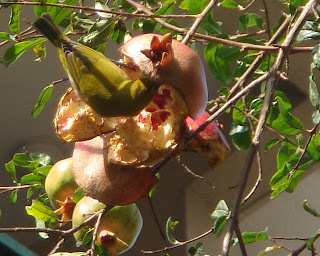
 The squirrel, evening brown butterfly and common Castor butterfly are the other regulars I have observed at various times.
The squirrel, evening brown butterfly and common Castor butterfly are the other regulars I have observed at various times.



|
Posted by
Susan Sharma
on
December 28, 2009
 This winter we have not had many butterflies in the garden; may be because it has been a dry winter with no signs of rains coming. So I was thrilled when the blue pansy flitted about under the morning sun. First on the yellow chrysanthemums and then on the
Asoka Tree.
This winter we have not had many butterflies in the garden; may be because it has been a dry winter with no signs of rains coming. So I was thrilled when the blue pansy flitted about under the morning sun. First on the yellow chrysanthemums and then on the
Asoka Tree.


|
Posted by
Susan Sharma
on
September 30, 2009

This year the rains came late and lingered till end of August. The butterflies and moth caterpillars waste no time in completing their life cycles; Here are some I managed capturing on the lens, in the beginning of September.
 The above picture is that of a lime butterfly caterpillar which is probably in its third stage (instar)of moulting. The picture below is that of the same caterpillar after two more moultings. Now it is in its last ’instar’ and the next stage will be the pupa
and then the lime butterfly. The host plant is the Chinese Orange tree.
The above picture is that of a lime butterfly caterpillar which is probably in its third stage (instar)of moulting. The picture below is that of the same caterpillar after two more moultings. Now it is in its last ’instar’ and the next stage will be the pupa
and then the lime butterfly. The host plant is the Chinese Orange tree.
 If the caterpillars of lime butterfly are fast eaters, they pale in comparison with the moth caterpillar’s eating capacity. The picture below is that of the Elephant Yam moth caterpillar. This one could devour huge leaves of the yam plant overnight and was
found hiding beneath the leaf during the day. I could not observe this caterpillar in its next stage; probably a mynah or babbler found this packaged fast food irresistible. The caterpillar disappeared sometime during the day.
If the caterpillars of lime butterfly are fast eaters, they pale in comparison with the moth caterpillar’s eating capacity. The picture below is that of the Elephant Yam moth caterpillar. This one could devour huge leaves of the yam plant overnight and was
found hiding beneath the leaf during the day. I could not observe this caterpillar in its next stage; probably a mynah or babbler found this packaged fast food irresistible. The caterpillar disappeared sometime during the day.

|
Posted by
Susan Sharma
on
April 10, 2008
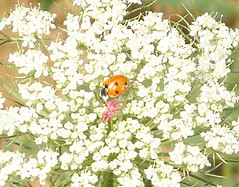
Ladybugs, 720,000 of them, have been released in New York City to help protect one of the city’s biggest apartment complexes from pests.
The bugs will crawl into plants, flowers and shrubs in the Stuyvesant Town and Peter Cooper Village complex in search of insects whose smell attracts them. Buying the bugs-at $16.50 for 2,000-means the complex’s owner can avoid using chemical insecticides.
"In most cases,we reach out to a can of pesticide-and we kill not only the ’bad guys’ but the ’good guys’, said Eric Vinje, owner of Planet Natural, which supplied the pestkillers.
He said a ladybug can eat up to 50 pests a day, plus insect eggs.
Source: The Hindu, Ocober 22, 2007
Photo: Ladybug on a carrot flower. The flowers are white with a pink centre to attract bees and insects. (Susan Sharma)
|